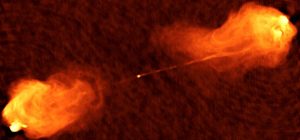Off-kilter, curved, and otherwise unusual beams of plasma from galaxies’ cores might track the dueling dances of two supermassive black holes.
Nearly every big galaxy has a gigantic black hole in its core. But many galaxies may have more than one — in fact, we expect them to: When galaxies merge to make a new stellar metropolis, their central supermassive black holes should slowly migrate to the new galactic downtown and join together in an inexorable inspiral.

NRAO / AUI
Astronomers are piling up evidence that these pairs of gigantic black holes exist, from spectral patterns in the glow from gas around black holes to extended, X-shaped structures that may have been blown out by jets from one black hole knocked askew by another. But observers have had trouble finding ones that lie less than 1 parsec (3.26 light-years) apart. The number of candidates is nowhere near as many as expected, explains Mitch Begelman (University of Colorado, Boulder).
This is a problem. Mergers are a major part of galaxy evolution. The most cataclysmic smashups tended to happen in the first few billion years of the universe, but today’s large galaxies are still tearing up small ones and swallowing them in pieces. Simulations suggest that many big black holes might lurk in the outskirts of galaxies like the Milky Way, and at least some should, over billions of years, make their way to galaxies’ cores. In short, supermassive black hole binaries are galaxy mergers’ natural outcome.
Furthermore, theorists are still trying to figure out how the biggest black holes jump the hurdle of the final few light-years and merge — calculations suggest they might stall in place. If so, there should be a lot of black holes doomed to stay at this arm’s-length distance from each other.
As part of the ongoing effort to find close binaries, Martin Krause (University of Tasmania, Australia, and University of Hertfordshire, UK) and an international team dug through existing radio maps of 33 galaxies whose central black holes are shooting intense, narrow beams of relativistic particles across tens of thousands of light-years. Normally, these jets travel on a ballistic trajectory, blowing out humongous lobes in the gas around the galaxy that can look like a wad of cotton candy on the end of a stick. But if the black hole launching the jet orbits another black hole, then the jet’s orientation will change with time.
This change happens for two reasons. First, there’s the big looping movement as the black hole travels through its orbit, creating a widening helical pattern whose size depends on how long the orbit takes. Second, the black hole’s axis will wiggle around as the black hole traverses the strangely warped spacetime landscape the binary creates.
The jet records these changes in various ways. Sometimes the jet might point at the edge of the lobe it blew, instead of down the barrel as we expect it to. Sometimes it will leave a ring of hotspots as it trails across the lobe. Sometimes it will curve without clear explanation. And sometimes, these effects are mirrored on both sides of the galaxy in a symmetric pattern, which you’d expect if they’re coming from two jets funneled out from the same object.
Of the 33 sources the team studied, 24 (73%) showed at least two of these effects. Of those, 14 (42%) manifested at least three signs.
No single conclusive case emerged, although as the astronomers explain in the January 1st Monthly Notices of the Royal Astronomical Society, the oft-studied Cygnus A looks promising: Its clearly off-axis jet could arise if a pair of black holes orbits each other every 18 years in the galaxy’s core, corresponding to (very roughly) a light-year between the two objects. (This is different that the mystery object in Cygnus A that might be the core of an eaten galaxy.)
The results complement work by David Roberts (Brandeis University), Lakshmi Saripalli (Raman Research Institute, India), and their colleagues studying S- or Z-shaped galaxy outflows, which provide what Roberts describes as “dramatic evidence” of jet motion. Combining these and other studies, it seems likely that there’s a substantial population of supermassive black hole binaries in massive galaxies, he says.
But other factors could explain the kinks, tilts, and wiggles Krause and his colleagues have documented. One possibility is changes to the disks of gas that skirt the black holes and power the jets, cautions Julie Comerford (University of Colorado, Boulder), who also hunts for such binaries.
It’ll be difficult to confirm any of the 33 candidates — the only possibility is the gargantuan galaxy M87, in which the putative pair might send out gravitational waves we could detect with an array of pulsars. So although promising, these candidates will unfortunately have to stay candidates for the foreseeable future.
Reference:
M. G. H. Krause et al. “How Frequent Are Close Supermassive Binary Black Holes in Powerful Jet Sources?” Monthly Notices of the Royal Astronomical Society. January 1, 2019.
 0
0









Comments
You must be logged in to post a comment.